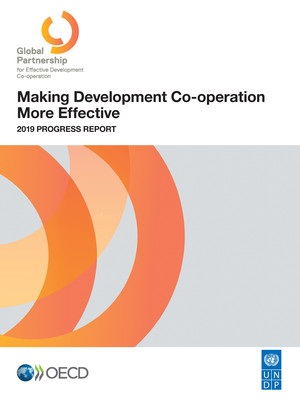copy the linklink copied!Reader’s guide
copy the linklink copied!The 2018 Global Partnership Monitoring Round: The methodology
The Global Partnership monitoring exercise differs from other global accountability frameworks in that its focus is on the quality of partnering that takes place to deliver development results and outcomes, rather than on the results themselves. Recognising the unique roles and responsibilities of each actor, the Global Partnership monitoring exercise is country-led and voluntary and aims to strengthen multi-stakeholder dialogue at country, regional and global level. The exercise drives change in the way development co-operation is provided by collecting country-generated data that highlight where progress is being made and where challenges persist, and thus brings together stakeholders around concrete findings to chart a new path forward.
The Global Partnership monitoring exercise is country-led. Partner country governments, on a voluntary basis, opt to conduct the monitoring exercise in their country.1 Each participating partner country assigns a government focal point to lead the monitoring exercise in country. While it is led by the government, the exercise aims to strengthen multi-stakeholder dialogue. The 2018 Monitoring Guide for National Co-ordinators (GPEDC, 2018[1]) recommends that the government focal points that are leading the exercise collaborate with representatives from bilateral and multilateral development agencies, civil society, the private sector, parliamentarians, and other relevant actors in order to collect data for the exercise with the support and guidance of the Joint Support Team of the OECD and the UNDP.
Multi-stakeholder validation of country-generated data is an important part of the monitoring process, ensuring high-quality reporting and strengthening mutual understanding of progress and challenges in meeting effectiveness commitments. As a consequence, government focal points are encouraged to invite representatives from across stakeholder groups to come together during the validation phase. By embedding the process in national mechanisms and providing strong government capacity, leadership and adequate resources, more than half of the partner countries that participated (46 of 86) conducted the monitoring exercise as a comprehensive multi-stakeholder process at country level. Others (40 of 86), while eager to participate, carried out the exercise as a multi-stakeholder process to varying degrees, depending on country context and context-specific challenges.
The process of carrying out the monitoring exercise has several benefits. For partner country governments, the exercise builds national capacity to monitor effectiveness in country. It also serves as an entry point to mobilise and engage with a broad range of stakeholders on the quality of ongoing co-operation, strengthening relationships and building trust. For development partners, the exercise provides a platform to identify where progress is needed in order to work more effectively with partner countries and encourages the development of joint solutions to shared challenges. For domestic development actors, the monitoring exercise provides a unique multi-stakeholder process to engage in dialogue with government and international partners and to identify solutions for more effective development partnerships. The Global Partnership reports on progress through ten indicators that capture the essence of the four principles for effective development co-operation. Some of these indicators have their roots in the Paris Declaration on Aid Effectiveness (OECD, 2005[2]); others were introduced in 2012 to capture the broader dimensions of the Busan Partnership agreement, as called for by developing countries. In 2017, a comprehensive review of the indicators was conducted in line with the renewed mandate of the Global Partnership to better reflect the opportunities of the 2030 Agenda.2 Throughout this report, associated methodologies of the ten indicators are described in broad terms where necessary (often in a box) for clarification of the text. A comprehensive account of the methodology of Global Partnership monitoring is contained in the 2018 Monitoring Guide for National Co-ordinators (GPEDC, 2018[1]), the Technical Companion Document (GPEDC, 2018[3]), the 2018 Monitoring Round: Mini Guide for Development Partners (GPEDC, 2018[4]) and the Indicative Terms of Reference for Development Partners (GPEDC, 2018[5]).
copy the linklink copied!How to read this report
All findings and conclusions presented in this report draw on data from the 2018 Global Partnership Monitoring Round unless otherwise stated or referenced. Where a comparison is drawn with 2016, this refers to data from the 2016 Global Partnership Monitoring Round. For comparisons with 2011, data from Paris Declaration monitoring (OECD, 2005[2]) are used.
For clarity on language used throughout this Progress Report and for ease of reference:
-
“Partner country or territory” is used to refer to developing countries and territories that reported to the Global Partnership Monitoring Round in 2018.3
-
“Development partner” is used to refer to official agencies, including state and local governments, or to their executive agencies that provide development co-operation. This includes Development Assistance Committee (DAC) and non-DAC bilateral partners, as well as multilateral development partners including, for example, multilateral development banks and vertical funds.
-
“Development actors” is used to refer to the full range of development stakeholders. This includes, for example, civil society and development partners as defined above as well as non-traditional development partners (e.g. the private sector and foundations).
All percentages that refer to partner countries are to be interpreted as proportions of the overall 2018 monitoring sample of 86 participating partner countries unless otherwise specified. Some percentages describe a subset of the 86 partner countries.
Notes
← 1. The Co-Chairs of the Global Partnership launched the monitoring exercise by issuing an invitation letter at ministerial level to partner countries to participate in the 2018 Monitoring Round.
← 2. The review was guided by technical advice from a monitoring advisory group, lessons learnt from the 2016 Global Partnership Monitoring Round and online consultations. More information is available on the Global Partnership website at: http://effectivecooperation.org/monitoring-country-progress/global-partnership-monitoring-2-0/track-2-adapting-monitoring-to-new-challenges.
← 3. Participation in this process and mention of any participant in this document are without prejudice to the status or international recognition of a given country or territory.
Metadata, Legal and Rights
https://doi.org/10.1787/26f2638f-en
© OECD and UNDP 2019
The use of this work, whether digital or print, is governed by the Terms and Conditions to be found at http://www.oecd.org/termsandconditions.


